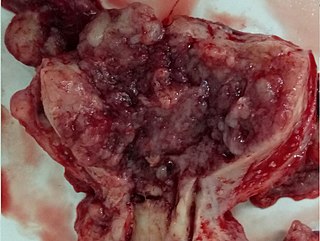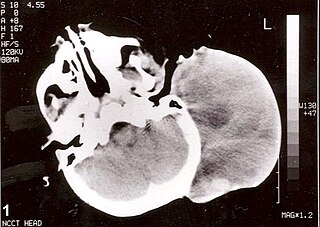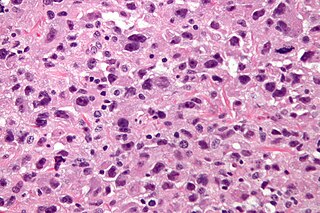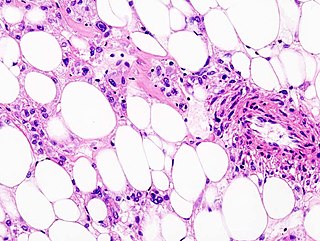
A soft-tissue sarcoma(STS) is a malignant tumour, a type of cancer, that develops in soft tissue. A soft tissue sarcoma is often a painless mass that grows slowly over months or years. They may be superficial or deep-seated. Any such unexplained mass will need to be diagnosed by biopsy. Treatment may include, surgery, radiotherapy, chemotherapy, and targeted drug therapy. The other type of sarcoma is a bone sarcoma.

A sarcoma is a malignant tumor, a type of cancer that arises from transformed cells of mesenchymal origin. Connective tissue is a broad term that includes bone, cartilage, fat, vascular, or hematopoietic tissues, and sarcomas can arise in any of these types of tissues. As a result, there are many subtypes of sarcoma, which are classified based on the specific tissue and type of cell from which the tumor originates. Sarcomas are primary connective tissue tumors, meaning that they arise in connective tissues. This is in contrast to secondary connective tissue tumors, which occur when a cancer from elsewhere in the body spreads to the connective tissue. The word sarcoma is derived from the Greek σάρκωμα sarkōma "fleshy excrescence or substance", itself from σάρξ sarx meaning "flesh".

Uterine cancer, also known as womb cancer, are two types of cancer that develops from the tissues of the uterus. Endometrial cancer forms from the lining of the uterus and uterine sarcoma forms from the muscles or support tissue of the uterus. Symptoms of endometrial cancer include unusual vaginal bleeding or pain in the pelvis. Symptoms of uterine sarcoma include unusual vaginal bleeding or a mass in the vagina.

The retroperitoneal space (retroperitoneum) is the anatomical space behind (retro) the peritoneum. It has no specific delineating anatomical structures. Organs are retroperitoneal if they have peritoneum on their anterior side only. Structures that are not suspended by mesentery in the abdominal cavity and that lie between the parietal peritoneum and abdominal wall are classified as retroperitoneal.

Rhabdomyosarcoma, or RMS, is an aggressive and highly malignant form of cancer that develops from skeletal (striated) muscle cells that have failed to fully differentiate. It is generally considered to be a disease of childhood, as the vast majority of cases occur in those below the age of 18. It is commonly described as one of the "small, round, blue cell tumours of childhood" due to its appearance on an H&E stain. Despite being a relatively rare cancer, it accounts for approximately 40% of all recorded soft tissue sarcomas.

The term fibromatosis refers to a group of soft tissue tumors which have certain characteristics in common, including absence of cytologic and clinical malignant features, a histology consistent with proliferation of well-differentiated fibroblasts, an infiltrative growth pattern, and aggressive clinical behavior with frequent local recurrence. It is classed by the World Health Organization as an intermediate soft tissue tumor related to the sarcoma family.

Fibrosarcoma is a malignant mesenchymal tumour derived from fibrous connective tissue and characterized by the presence of immature proliferating fibroblasts or undifferentiated anaplastic spindle cells in a storiform pattern. It is usually found in males aged 30 to 40. It originates in fibrous tissues of the bone and invades long or flat bones such as the femur, tibia, and mandible. It also involves the periosteum and overlying muscle.

Leiomyosarcoma, is a malignant (cancerous) smooth muscle tumor. A benign tumor originating from the same tissue is termed leiomyoma. While it has been believed that leiomyosarcomas do not arise from leiomyomas, there are leiomyoma variants for which classification is evolving.
The uterine sarcomas form a group of malignant tumors that arises from the smooth muscle or connective tissue of the uterus.

Undifferentiated pleomorphic sarcoma, previously malignant fibrous histiocytoma, is a type of cancer, namely a soft-tissue sarcoma.

A malignant mixed Müllerian tumor, also known as malignant mixed mesodermal tumor (MMMT) is a cancer found in the uterus, the ovaries, the fallopian tubes and other parts of the body that contains both carcinomatous and sarcomatous components. It is divided into two types, homologous and a heterologous type. MMMT account for between two and five percent of all tumors derived from the body of the uterus, and are found predominantly in postmenopausal women with an average age of 66 years. Risk factors are similar to those of adenocarcinomas and include obesity, exogenous estrogen therapies, and nulliparity. Less well-understood but potential risk factors include tamoxifen therapy and pelvic irradiation.

Alveolar soft part sarcoma, abbreviated ASPS, is a very rare type of soft-tissue sarcoma, that grows slowly and whose cell of origin is unknown.

Ewing's sarcoma is a type of cancer that may be a bone sarcoma or a soft-tissue sarcoma. Symptoms may include swelling and pain at the site of the tumor, fever, and a bone fracture. The most common areas where it begins are the legs, pelvis, and chest wall. In about 25% of cases, the cancer has already spread to other parts of the body at the time of diagnosis. Complications may include a pleural effusion or paraplegia.

Spindle cell sarcoma is a type of connective tissue cancer in which the cells are spindle-shaped when examined under a microscope. The tumors generally begin in layers of connective tissue such as that under the skin, between muscles, and surrounding organs, and will generally start as a small lump with inflammation that grows. At first the lump will be self-contained as the tumor exists in its stage 1 state, and will not necessarily expand beyond its encapsulated form. However, it may develop cancerous processes that can only be detected through microscopic examination. As such, at this level the tumor is usually treated by excision that includes wide margins of healthy-looking tissue, followed by thorough biopsy and additional excision if necessary. The prognosis for a stage 1 tumor excision is usually fairly positive, but if the tumors progress to levels 2 and 3, prognosis is worse because tumor cells have likely spread to other locations. These locations can either be nearby tissues or system-wide locations that include the lungs, kidneys, and liver. In these cases prognosis is grim and chemotherapy and radiation are the only methods of controlling the cancer.
Congenital mesoblastic nephroma, while rare, is the most common kidney neoplasm diagnosed in the first three months of life and accounts for 3-5% of all childhood renal neoplasms. This neoplasm is generally non-aggressive and amenable to surgical removal. However, a readily identifiable subset of these kidney tumors has a more malignant potential and is capable of causing life-threatening metastases. Congenital mesoblastic nephroma was first named as such in 1967 but was recognized decades before this as fetal renal hamartoma or leiomyomatous renal hamartoma.
Plural disease occurs in the pleural space, which is the thin fluid-filled area in between the two pulmonary pleurae in the human body, there are several disorders that can occur

Kaposi's sarcoma (KS) is a type of cancer that can form masses in the skin, lymph nodes, or other organs. The skin lesions are usually purple in color. They can occur singularly, in a limited area, or be widespread. It may worsen either gradually or quickly. Lesions may be flat or raised. Human herpesvirus 8 (HHV8) is found in the lesions of all those who are affected. Risk factors include poor immune function, either as a result of disease or specific medications, and chronic lymphedema.

Perivascular epithelioid cell tumour, also known as PEComa or PEC tumour, is a family of mesenchymal tumours consisting of perivascular epithelioid cells (PECs). These are rare tumours that can occur in any part of the human body.
Primary bone is the first bone tissue that appears in embryonic development and in fracture repair. It is characterized by its random position of collagen fibers. In most places in adults this tissue is replaced by secondary bone tissue except, for example, near the sutures of calvara or tooth sockets. The secondary bones have lower amounts of osteocytes so primary bone is much more easily penetrated by x-ray.

Endometrial stromal sarcoma is a malignant subtype of endometrial stromal tumor arising from the stroma of the endometrium rather than the glands. There are three grades for endometrial stromal tumors, as follows. It was previously known as endolymphatic stromal myosis because of diffuse infiltration of myometrial tissue or the invasion of lymphatic channels.















